| National Parks | The Sea | Activities | Art and Culture | Towns and Cities | Food & Drink | Climate |
| News | Contact | Holiday Accommodation |
The National Parks
Moves towards developing and implementing a nature reserve concept in the Abruzzi region began back in the 1920s. The Abruzzi National Park was established in 1922, making it the oldest in Italy and one of the oldest in Europe. The Maiella National Park, the Gran Sasso National Park and the Sirente-Velino Regional Park were set up during the 1990s.
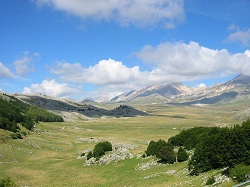
|
37 nature reserves were also established in addition to this. 33% of the Abruzzi region's entire area has been made into a national nature reserve, the highest percentage of any region in Europe. This unspoilt landscape with its many species of animals is the ideal place to explore.
| The Gran Sasso National Park |  |
 |
| Please click on the images to see an enlargement. |
Campo Imperatore is 30 km long and about 8 km wide. During the summer months, this a wonderful place in which to ride and hike, while during the winter it provides an ideal setting for unforgettably unique cross-country skiing or snowshoe expeditions. Hikers setting out to discover the valleys, canyons, peaks and pastures will find themselves stopping on numerous occasions, not only to wipe the sweat from their brows but also to admire the wonderful landscape and breathtaking beauty of this area. And even if you're not too keen on walking for miles, you can still enjoy most of the area's beauty by car.
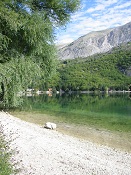
|
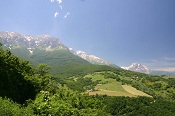
|
And it is from this plateau that access is gained to the eternal snow of the Calderone, Europe's most southerly glacier. At these altitudes, you will be able to enjoy the crystalline shape of the Apennine edelweiss and the colours of the mountain orchids and gentian. And with a bit of luck you might also be greeted with the sight of an Abruzzi ibex or golden eagle.
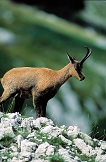
|
After climbing for around an hour from Campo Imperatore, you'll be treated to views across the whole of central Italy, from the beaches of the Adriatic coast in the east to the Tyrrhenian Sea in the west - provided, that is, that it's a clear day. Further to the north, you will find Campotosto lake and the "valley of the hundred waterfalls". This is where the Gran Sasso massif passes over into the more gentle Monti della Laga. The landscape is characterized by its pine, beech and birch forests (the latter is a rarity in Italy), which are peppered with small and clear streams. These watercourses combine to form a large number of waterfalls that are a spectacular sight in summer. And in winter they freeze over creating a wonderful natural spectacle.
| The Maiella National Park |  |
The Maiella mountains are named after the mysterious Greek heroine Maja, who searched for medicinal herbs in the Abruzzi mountains for her son who had been fatally wounded in battle. Locals say that the morphology of the Maiella chain of mountains resembles the silhouette of Maja. Now turned to stone, she protects her sons, the people of the Abruzzi region. And is for this reason that the locals like to refer to it as "Montagna madre" (Mother mountain) or "Montagna Sacra" (holy mountain).
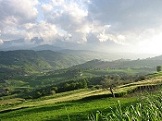
|
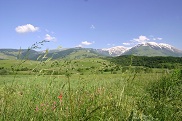
|
The Maiella National Park stretches across 86,000 hectares. With the Monte Amaro, the Maiella massif range reaches
a height of 2,795 m. During the summer the slopes are lush, green and there are plenty of forests and sources of water.
The Maiella is a limestone range. It has a total of 61 peaks. Most of these can be climbed easily. Some of the plateaus have
a lunar landscape. With over 1,800 different species of fauna and flora, this a paradise for mountain botanists from all
over the world. The spring bloom has to be seen to be believed. As the legend indicates the flora is particularly rich in
medicinal herbs. The Alpine poppy and the Maiella edelweiss can be enjoyed on the highest peaks.
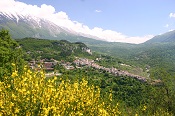
|
Over the last few years the attractive Apennine Wolf (Lupus italicus) has been more frequently seen. The same is true of the brown bears (Ursus arctus marsicanus), the golden eagles, chamois and the pellegrin falcons. As an environmental indicator of intake ecosystems, the shy otter is also at home here.
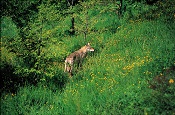
|
The Maiella range is able to accommodate this rich variety of species thanks to its landscape which unites Mediterranean and Alpine aspects as well as characteristics of the Balkans and Pyreneans.
But the Maiella region is not only an area of rich ecology. Human culture can be traced back 300,000 years. The characteristic beauty of the landscape also made the region a magnet for ascetic and hermits during the early period of Christianity, who built a large number of sanctuaries and hermitages some of which are in spectacular locations. In the more recent past it has been pastoral nomadism ("Transumanza") and the "Tholos", the round characteristic stone buildings, that have also become a characteristic of the region.
| Sirente-Velino Regional Park |  |
The Sirente-Velino regional park is made up of two same-name massifs and is situated to the west of the Gran Sasso in the interior. Given that both seas (the Adriatic and the Tyrrhenian) are further away, the climate is more continental. This means that winters here are colder than in the other parks. The peaks usually remain snow-capped until late spring. Here, too, the steep faces of the Sirente, lovely canyons (Gole di Celano), plateaus and interesting karst formations (Stiffe caves) offer a wide choice of attractions. The mountains' sheltered location has led to time standing still in many villages. Indeed, there are a number villages and small towns with towers and castles, which have survived the last few centuries without damage. The archaeological digs of Alba Fucens and Peltunium also bear witness to the Roman expansion around 400 AD. The Santa Maria church in Valle Porcianeta, the Celano castle and several testaments to the grazing culture such as the "Pagliare" are also well worth a visit.
| The Abruzzi National Park |  |
The symbol of the Abruzzi National Park, the most southerly and oldest region is the brown bear (orso bruno marsicano). The park encompasses an area of 44,000 hectares and a similarly large protected area in the direct vicinity. Over 100 brown bears, 50 wolves, 500 chamois, fallow deer, as well as several lynx and otters live in the park. In the neighbouring Penne nature reserve work is progressing on several ecology projects and scientific research. A number of bad planning decisions during the 60s unfortunately led to an influx of Italian tourists to the park, which really put the park under pressure. Since the reintroduction of wolves during the 70s, however, the park has been slowly recovering from the mistakes of the past.
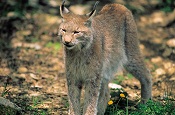
|
So-called "Aree faunistiche", small didactic reserves, have been established in all the parks. These areas have been set up to enable certain wild animals to be observed, bred and learnt about, as well as to care for injured animals. In these segregated areas and with a little patience, you can watch the animals in their natural environment.
© lupus-italicus
© (Photo)